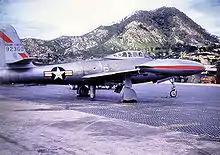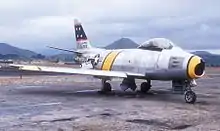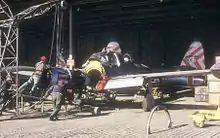Daegu International Airport 대구국제공항 大邱國際空港 Daegu Gukje Gonghang Taegu Kukche Konghang | |||||||||||||||
|---|---|---|---|---|---|---|---|---|---|---|---|---|---|---|---|
 | |||||||||||||||
| Summary | |||||||||||||||
| Airport type | Public / Military | ||||||||||||||
| Owner | Ministry of Land, Infrastructure and Transport | ||||||||||||||
| Operator | |||||||||||||||
| Serves | Daegu and North Gyeongsang | ||||||||||||||
| Location | Dong District, Daegu, South Korea | ||||||||||||||
| Opened | 1 April 1961 | ||||||||||||||
| Built | 31 January 1937 | ||||||||||||||
| Elevation AMSL | 116 ft / 35 m | ||||||||||||||
| Coordinates | 35°53′39″N 128°39′32″E / 35.89417°N 128.65889°E | ||||||||||||||
| Website | www.airport.co.kr/daegu | ||||||||||||||
| Map | |||||||||||||||
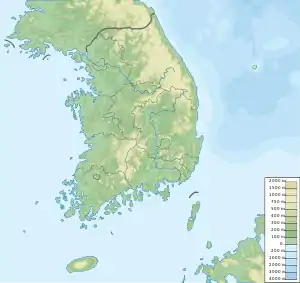 TAE Location of airport in South Korea 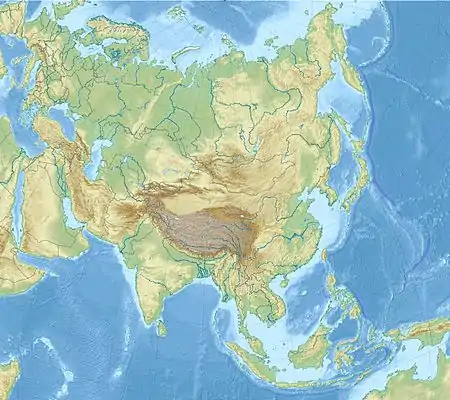 TAE TAE (Asia) 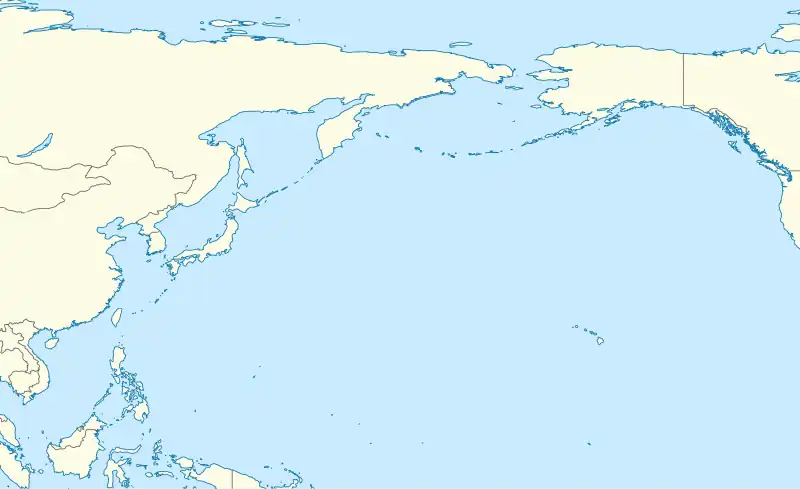 TAE TAE (North Pacific ) .svg.png.webp) TAE TAE (Earth) | |||||||||||||||
| Runways | |||||||||||||||
| |||||||||||||||
| Statistics (2019) | |||||||||||||||
| |||||||||||||||
Statistics from KAC[1] | |||||||||||||||
Daegu International Airport (Hangul: 대구국제공항; Hanja: 大邱國際空港; Revised Romanization: Daegu Gukje Gonghang; McCune-Reischauer: Taegu Kukche Konghang) (IATA: TAE, ICAO: RKTN) is an international airport serving the city of Daegu and the surrounding area in the southeast of South Korea. The airport is also a military base for the ROKAF's 11th Fighter Wing, whose three squadrons fly the F-15K.
Overview
The airport chiefly serves domestic routes with a small number of international flights. Despite the growth of the nearby city of Daegu, passenger numbers at Daegu International Airport have been steadily declining since 2004, the year when KTX highspeed rail reached the city. The 2013 number of about 1.1 million passengers is around half of pre-2003 figures. Since 2014, passenger numbers have increased sharply due to the expansion of Low-Cost Carriers. Because Daegu Airport is shared with the military, taking photographs or video of the apron, the runway or the military facility is strictly prohibited.
History
Daegu International Airport was originally established under Japanese rule as Taegu Airfield on 31 January 1937.[2]
Korean War
At the outbreak of the Korean War, the airfield consisted of a dirt and gravel runway and two concrete buildings.[3] The airfield was designated by the USAF as K-2.
The airfield was used as part of the Bout One project, an emergency program to train Republic of Korea Air Force pilots to fly the F-51 Mustang. The Bout One planes provided close air support to the U.S. 24th Infantry Division through July 1950.[3]: 89–90 On 10 July 1950, the Bout One force was re-designated as the 51st Fighter Squadron,[3]: 95 and was merged into the 12th Fighter-Bomber Squadron on 4 August.[3]: 112
The existing dirt and gravel runway was improved by the 822nd Engineer Aviation Battalion beginning on 18 July, and the Battalion subsequently began preparations for a parallel 5,000 foot (1,500 m) PSP (perforated steel planks) runway on 7 August.[3]: 110
USAF units based at Taegu from July–August 1950 included:
- 18th Fighter-Bomber Group, from July–August 1950, subordinate units included:
- 12th Fighter-Bomber Squadron operating F-51 from 15 July 1950[3]: 95
- 51st Fighter Squadron (Provisional) from 10 July–August 4, 1950[3]: 95
- 6002nd Air Base Squadron from July–8 August 1950[3]: 95
- 6147th Tactical Control Squadron (Airborne) operating T-6 Mosquitos from 1 August–September 6, 1950[3]: 106
- 6149th Air Base Unit from August 1950
Taegu Airfield was abandoned following the North Korean attack on Taegu in mid-August 1950, but USAF units began reoccupying the base by 23 September 1950.[3]: 176 The 822nd Battalion had returned to Taegu on 17 September and soon resurfaced the original dirt and gravel runway with PSP and extended its length to 5,700 feet (1,700 m).[3]: 177
USAF units based at Taegu from September 1950 included:[3]: 177
- 49th Fighter-Bomber Group operating F-80s from 1 October 1950. This was the first jet unit to be based in Korea. Subordinate units included:
- 7th Fighter-Bomber Squadron from 28 September
- 8th Fighter-Bomber Squadron from 29 September
- 9th Fighter-Bomber Squadron from 29 September
- 543rd Tactical Support Group from 26 September, subordinate units included:
- 8th Tactical Reconnaissance Squadron, Photo-Jet operating RF-80s from 2 October
- 162nd Tactical Reconnaissance Squadron, Night Photo from 8 October
- 363rd Reconnaissance Technical Squadron from 4 October
In May 1951, the 930th Engineer Aviation Group began repair work on the PSP runway and commenced construction of a 9,000 feet (2,700 m) concrete runway.[3]: 395
Postwar
Passenger facilities

Daegu Airport consists of 2 separate terminals: Domestic Terminal and International Terminal. The relatively small passenger terminal (International Terminal) boasts a comfortable environment through its adoption of traditional design elements symbolizing Ouga (The song of five friends: water, rock, pine, bamboo, and moon; by Yun Son-Do), and its crane-like structure. The parking lot can accommodate about 1,097 cars and has a fully automated parking system; it is open from 6 am to 10 pm.[4]
Airlines and destinations
Statistics
Traffic by calendar year
| Passenger volume | Aircraft operations | Cargo tonnage | |
|---|---|---|---|
| 2001 | 2,214,613 | 18,511 | 17,564 |
| 2002 | 2,274,901 | 19,984 | 19,825 |
| 2003 | 2,228,550 | 20,729 | 20,823 |
| 2004 | 1,567,678 | 15,021 | 22,803 |
| 2005 | 1,236,446 | 11,837 | 20,565 |
| 2006 | 1,194,150 | 11,111 | 19,898 |
| 2007 | 1,177,490 | 10,997 | 19,619 |
| 2008 | 1,079,011 | 9,691 | 18,247 |
| 2009 | 1,026,203 | 8,257 | 17,669 |
| 2010 | 1,148,953 | 8,287 | 18,526 |
| 2011 | 1,178,212 | 8,489 | 19,724 |
| 2012 | 1,110,290 | 8,413 | 18,352 |
| 2013 | 1,084,585 | 8,794 | 16,383 |
| 2014 | 1,537,328 | 11,832 | 18,808 |
| 2015 | 2,027,626 | 14,369 | 20,480 |
| 2016 | 2,533,132 | 17,089 | 24,341 |
| 2017 | 3,560,124 | 23,191 | 32,031 |
| 2018 | 4,062,833 | 26,800 | 33,267 |
| 2019 | 4,669,057 | 31,236 | 34,718 |
| 2020 | 1,749,396 | 12,990 | 11,050 |
| 2021 | 2,048,365 | 13,294 | 10,583 |
| 2022 | 2,255,883 | 13,472 | 12,394 |
| Source: Korea Airports Corporation Traffic Statistics[11] | |||
Access
The airport is 1.34 km from Ayanggyo Station (Daegu Subway Line 1) and can be reached by bus or taxi.
Accidents and incidents
- On 26 May 2023, a male passenger opened the door of an Asiana Airbus A321 just a few minutes before landing. The plane made a safe landing, however a number of people had injuries. The man was arrested by authorities. [12]
See also
References
- ↑ "공항별 통계 : 항공통계 : 알림·홍보 : Kac 한국공항공사". Archived from the original on 20 January 2019. Retrieved 20 January 2019.
- ↑ Notice no. 40, 1937, Government-General of Korea. (in Japanese) JPNO 00084180 doi:10.11501/2959525
- 1 2 3 4 5 6 7 8 9 10 11 12 13 Futrell, Frank (1983). The United States Air Force in Korea, 1950–1953 (PDF). Air Force History & Museums Program. p. 89. ISBN 9780912799711.
 This article incorporates text from this source, which is in the public domain.
This article incorporates text from this source, which is in the public domain. - ↑ "Information for parking lot". Archived from the original on 15 March 2008.
- ↑ "JIN AIR ADDS DAEGU – TAIPEI SERVICE FROM LATE-DEC 2022". Aeroroutes. 28 November 2022. Retrieved 28 November 2022.
- ↑ ""국내선 지방/제주 운항 재개"". Koreanair. Retrieved 6 October 2023.
- ↑ "Korean Air Resumes Incheon – Daegu Service From April 2023". Aeroroutes. Retrieved 24 March 2023.
- ↑ "Mainland Chinese Carriers NS23 International / Regional Network – 14MAY23". Aeroroutes. Retrieved 16 May 2023.
- ↑ "T'Way Air NW22 Japan Operations – 27OCT22". Aeroroutes. 27 October 2022.
- ↑ "T'Way Air Adds Daegu – Ulaanbaatar Service From late-July 2023". AeroRoutes. 11 July 2023. Retrieved 11 July 2023.
- ↑ "KAC 한국공항공사"
- ↑ "Passenger held after Asiana plane door opens mid-air". 26 May 2023.
![]() This article incorporates public domain material from the United States Air Force
This article incorporates public domain material from the United States Air Force
